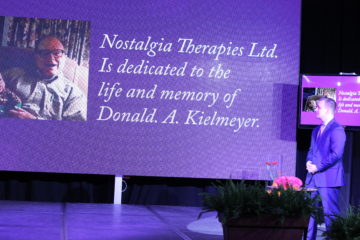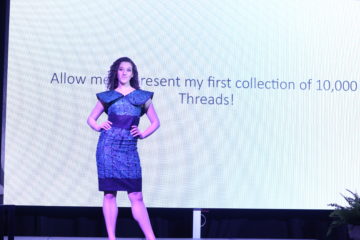By DAVID DUPONT
BG Independent News
The young entrepreneurs competing in The Hatch Thursday at Bowling Green State University were intent on solving social issues as well as launching companies.

Jacob Kielmeyer dedicated his proposal to his late grandfather.
For all the show business trappings — Kirk Kern’s game show demeanor as master of ceremonies and a live band – this was serious business.
Autism, Alzheimer’s disease, lack of clean drinking water in Guinea, opioid addiction, and career planning were all issues that Hatchlings wanted to address.
“You’ve all targeted some heady issues,” said Earl Malm, one of the alumni investors the Hatchlings were pitching their ideas to.
No matter how sincere they were in their approach or how serious the problem, it fell to the nine Hatchlings to make their cases.
This year’s Hatchlings and their products were: Fatima Camara, 10,000 Threads clothing line; Shannon Ebert, Workforce Academy; Andrew Hood and Sarah Walter, medication dispenser; Jacob Kielmeyer, Nostalgia Therapies—Alzheimer’s assistance; Joe Lisa, wearable charging device; Thomas Moody, virtual reality sales trainer; Marharita Tavpash, Ice Sleeve; and Cory Thompson, autism app.
“This is where education meets the street,” Malm said before the presentations began. “This is where Hatchlings graduate to become fledglings in business.”
And he said: “Not everyone will get a deal.”
Some got advice and a meeting instead.
Regardless, Malm said, it was just another step in their entrepreneurial journeys.

The Hatch band with lead singer Danny Carder and former Hatchling Sophia Schmitz on violin.
That journey has already been a long one for Fatima Camara. Born in New York City, she was raised in Guinea. As child visiting the market she was enthralled by the multi-colored hand woven and dyed fabric. Now she wants to create 10,000 Threads, a fashion company that will use that fabric for a clothing line aimed at women 25-44.
This, she told the investors, would benefit the local artisans who will gain a new more remunerative market. Camara said that part of the proceeds from the sales would benefit efforts to provide clean water to people in Guinea, where drinking tainted water is prevalent and deadly.
While her marketing plan called for selling her six designs over the internet, investor Brian Sokol had other ideas. “I’d like to take you to QVC,” he said. He said he was convinced that her story and personality are an essential part of the appeal of 10,000 Threads.
Other investors wondered whether her $120 price point for outfits was too low.
Camara said she wanted to make them accessible.
She secured her $10,000 investment.

Investor panel listens to proposal.
Jacob Kielmeyer, of Bowling Green, also had a story to tell. His product was inspired by his grandfather who had Alzheimer’s. The disease struck the grandfather when Kielmeyer was just 4. Kielmeyer said he never got to know him.
His product would be a computer tool that would use photos, music, puzzles and more to help patients connect with their pasts and their families.
Kielmeyer showed a video of retired theater professor Allen Kepke recognizing his daughter for the first time in years after using the program.
Kielmeyer was going for $65,000. A large chunk of that would go to pay for clinical trials. Getting some sort of accreditation would help set his product apart from others.
While people can do this with Facebook, he said, his product is much higher quality with has more possibilities to personalize it.
However, Michelle Drerup, who develops medical products, said he was greatly underestimating the cost of running clinical trials. They would cost more than twice as much as he was projecting.
Instead investor Joe Fisch offered a meeting with researchers from the Cleveland Clinic. The first meeting set for two weeks from now would be a conference call with a face-to-face meeting to follow if all went well.
That would be, he said, with the other investors concurring, the best way to develop Nostalgia Therapies.

Sarah Drummer models one of Fatima Camara’s designs.
Cory Thompson also focused a personalized solution to another neurological condition; he designed an app that would help adult with autism make decisions and function better in life
Working closely with Dr. Lynne Hewitt, of the BGSU faculty, he fine-tuned the product. He had someone who expressed interest in the value of the app, beta tested it for him along the way.
He believes the app can further be adapted for people with anxiety disorder, obsessive compulsive disorder, and traumatic brain injury.
He said he has approached the staff at Woodlane and they have expressed support for his work.
Still, he said, he would rely on face-to-face marketing to start. His biggest challenge, he said, would be trademarking the software.
The investors backed the graphic design student with $5,000.
Shannon Ebert, who will graduate next month with both bachelors and master’s degrees in the College of Education and Human Development, presented her proposal for learning and workforce development software. Her idea is to give high school students a better idea of how to determine what career to pursue and how to do it.
The software would combine elements of programs already available, including a personal finance component, into one package. This would help students avoid false career starts and excessive college debt. It could also mean more qualified employees.
The software was inspired by Ebert’s own success in taking college courses in high school and deciding early what career she wanted to pursue.
Sokol wondered if she could embed her own personality into the tool. Could the tool help other students achieve the same drive she has?
Ebert said she feels everyone has the capacity with the right information, presented in the right way, to make those decisions.
They were impressed enough to back her.
Another training tool, though, didn’t impress them quite as much. Thomas Moody’s Med X VR would use virtual reality software to train medical device sales representatives.
These sales reps do more than sell the devices. They are often in the operating room to consult on how the devices should be used.
Moody said Med X VR would better facilitate that training, allowing trainees, for example, to witness operations without traveling to a hospital. It would package content already available.
The investors liked his aggressive sales approach. “You could sell a popsicle to a kid in a white shirt,” Sokol said.
But Mark West said that hospitals are already moving to procedures where the reps don’t have to be in the operating room.
Matthew Yorkvitch wondered why companies themselves couldn’t put together similar training content with the same content Moody was planning to use.
Sarah Walter and Andrew Hood tackled another medical issue – how to control the dispensing of medications, especially opioids.
Given the opioid abuse problem, their dispensing container would control how many and when pills would be released. For caregivers, this could even be done remotely.
They said their medication dispenser would be more sophisticated than similar devices.
The investors, however, were not convinced there was enough of a market, and whether it would make much of an impact on the problem.
Joe Lisa pushed Sparq Charge, wearable cell phone charger. The charger would be connected to a lanyard that would have a wire embedded in it, so it could be plugged into a wall socket.
Drerup said she could have used it when she recently attended a conference. But she said, it would be more like something she’d expect to be given for free at the conference, not something she would buy.
Also, she said, most people don’t walk around with lanyards around their necks.
Malm suggested the best way to market the device would be to sell them outside events where people might use them.
The investors had more personal connection to Marharita Chill Paq.
Tavpash, a tennis player at the university, designed her ice pack after seeing the difficulty other athletes had getting existing products on to their injured and sore limbs.
The product has a flexible sleeve with a pack for ice that can fit around many different parts of the body and can be applied by athletes themselves without the help of a trainer.
She said the market for high school and college athletes is large since 63 percent report suffering injuries.
The investors felt that the product also could find a place in a broader aging demographic.
“I will tell you this is very impressive idea,” Sokol said. Sometimes he could use one “for my entire body.” He could see the Chill Pacq on the shelves at major chain pharmacies.
Everyone on the panel agree, and she walked away with a deal.





